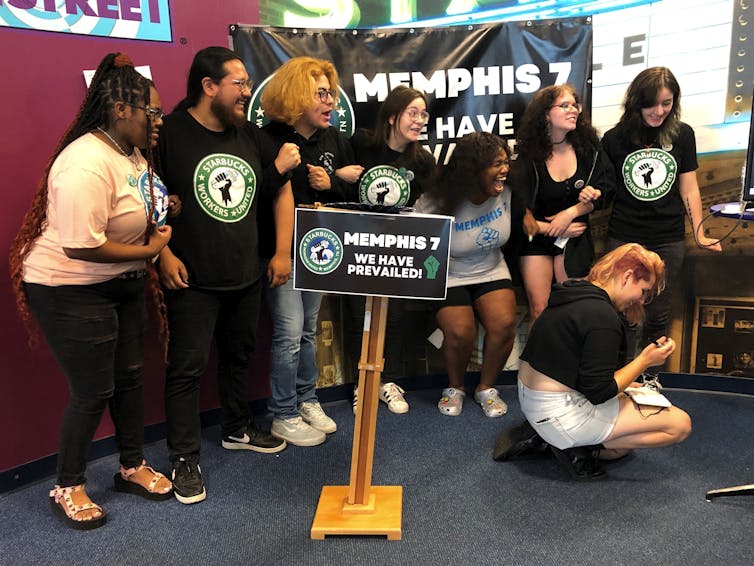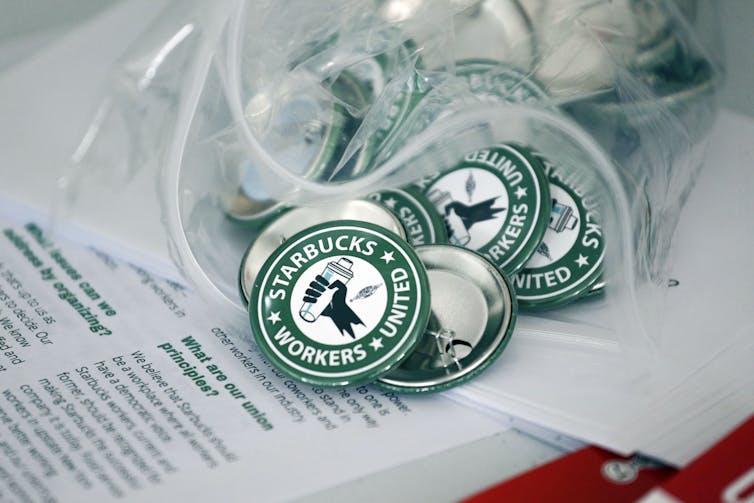(The Conversation) —
The Supreme Court has ruled in favor of Starbucks in a case that could make it harder for a federal agency to enforce labor laws in disputes that can arise during organizing campaigns. On June 13, 2024, the court announced that eight of the nine justices had signed onto a decision, written by Justice Clarence Thomas, on the Starbucks Corp. v. McKinney case. Justice Ketanji Brown Jackson concurred overall with the decision but dissented on some key points in a separate opinion.
The Conversation U.S. asked Texas A&M law professor Michael Z. Green to explain the significance of the court’s decision and how it could affect the right to organize unions in the United States.
What is this case about?
Seven baristas who were attempting to organize a union at a Starbucks shop in Memphis, Tennessee, were fired in February 2022. Starbucks justified their dismissal by asserting that the employees, sometimes called the “Memphis 7,” had broken company rules by reopening their store after closing time and inviting people who weren’t employees, including a television crew, to go inside.
In June of that year, the shop became one of more than 400 Starbucks locations since 2021 that have voted in favor of joining Workers United, an affiliate of the Service Employees International Union.
The union filed a charge over the mass dismissal with the National Labor Relations Board, the federal agency responsible for enforcing U.S. workers’ rights to organize. While resolution of the charge was pending, Kathleen McKinney, the NLRB director for the region that includes Memphis, sought an injunction in a federal district court to force Starbucks to give the Memphis 7 their jobs back immediately as the NLRB continued its process to reach a final decision.
The company must “cease its unlawful conduct immediately so that all Starbucks workers can fully and freely exercise their labor rights,” she said.
According to the NLRB, the injunction was appropriate in this case because Starbucks fired nearly all of the members of the union organizing committee at the Memphis store and the evidence showed the chilling effect this action had on the “lone remaining union activist.” This chilling effect “harmed the union campaign in ways that a subsequent Board ruling could not repair.”
By August 2022, a judge agreed with the NLRB and ordered Starbucks to reinstate the Memphis 7. The baristas were soon back on staff.
The company appealed the case all the way to the Supreme Court because, it asserted, the court should not have ordered the company to reinstate the workers while the NLRB proceedings were still pending.
But the NLRB argues, and the lower courts agreed, that the terminations chilled further union activities at the store even after the election.
As of today, five of the seven remain employed at the Memphis coffee shop.

AP Photo/Adrian Sainz
What are the tests at the heart of this case?
The justices have decided which approach federal courts should use when they consider requests for injunctions sought by the NLRB. Previously, different courts had used different standards.
Until now, five appeals courts, including the one where this case arose, had been basing their decisions on a two-part test:
First, the courts determine whether there is “reasonable cause” to believe an unfair labor practice has occurred. Second, they determine whether granting an injunction would be “just and proper.”
Four other appeals courts were using a four-part test:
First, the courts ask whether the unfair labor practice case is likely to succeed on the merits in establishing that labor violations occurred. Second, they look to see if the workers the NLRB is attempting to protect will face irreparable harm without an injunction. Third, after showing likelihood of success and irreparable harm, they ask whether those factors outweigh any hardships the employer is likely to face due to compliance with the court’s order. Fourth, they ask whether issuing the injunction serves the public interest.
Two other appeals courts had relied on a hybrid test that appears to have components of both tests. They ask whether issuing an injunction would be “just and proper” by considering the elements of the four-part test.
The majority ruled in favor of Starbucks by saying that all district courts must rely on a four-part test in these instances from now on.

AP Photo/Joshua Bessex
How common and serious are these situations?
In its Supreme Court brief, Starbucks asserted that having to give workers their jobs back in these circumstances can cause “irreparable injury” and that it’s an “extraordinary remedy.”
A Bloomberg Law analysis of Starbucks’ unfair labor practice cases, including the one involving the Memphis 7, determined that NLRB administrative law judges had found labor violations in 48 out of 49 cases.
Although the NLRB issues hundreds of unfair labor practice complaints against employers every year, it usually doesn’t turn to the courts to force the rehiring of employees – it only sought these types of injunctions 17 times in 2023, for example.
And seven of those efforts involved Starbucks. Despite the small number of overall injunctions, the large number of unfair labor practice complaints – and the eventual 48 out of 49 findings of violations – might support the rare use of injunctions in this case.
What’s the potential impact of this ruling?
This ruling may or may not have made it harder for union organizers to preemptively get their jobs back in cases like this.
While all judges will now have to apply the four-part test, the Supreme Court majority’s decision did not clarify how the test should be applied. Also, many courts were already using a four-part test.
Specifically regarding Starbucks, the underlying unfair labor practice case has been resolved, since the workers have gotten their jobs back and their workplace has joined a union.
What’s more, Starbucks has agreed to negotiate collective bargaining agreements with the union, which has continued to make inroads at the company’s coffee shops.
This is an updated version of an article published on April 23, 2024.
—
Read More News from The Conversation
